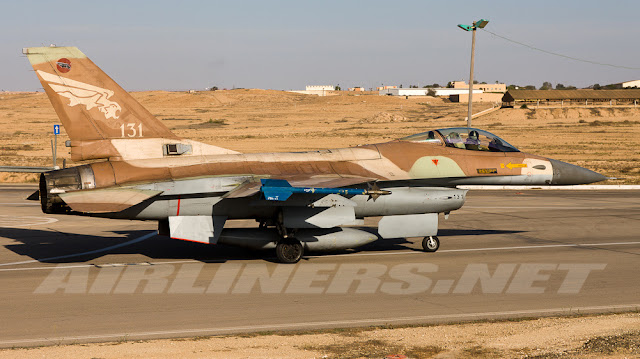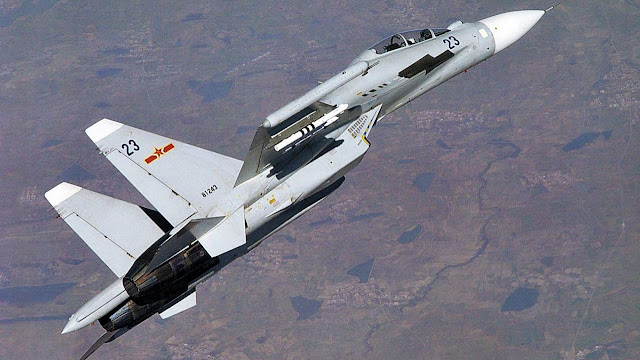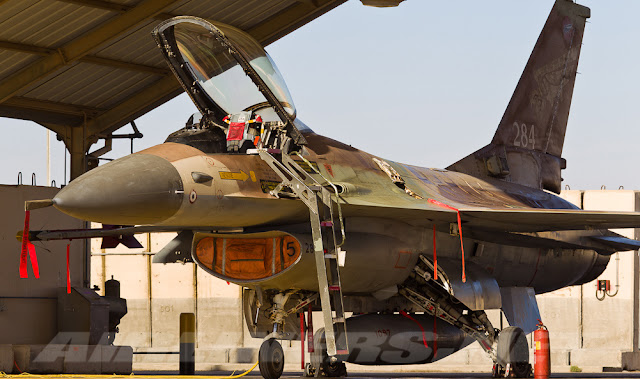 |
| An F-16A Netz. Photo courtesy of Andreas Zeitler thru Airliners.net |
There are rumors are that the Philippine Air Force (PAF) may be considering the F-16A Netz from Israel for possible acquisition, hence I thought it would be a good idea to try to see how it will fare against the main threat (for now) it will be facing it if does get chosen, which is China's SU-30MKK Flanker-G.
'Aircraft Backgrounds'
The SU-30 is an improved version of the SU-27 Flanker made by the Russian Federation’s “Sukhoi Company” and first entered service with the Russian Air Force in 1996. It is described as a heavy, long-range, all-weather strike fighter and around 400+ aircrafts have been built so far in service with 9 countries around the world. The SU-30MKK is the special export version to China of the SU-30 which went into Chinese Air Force service in 2000.
China ordered 76 aircraft which were delivered between 2000-2003, and in case of any war, it will be China’s main frontline aircraft as it is its most capable combat aircraft right now. The official NATO code name for the SU-30MKK is the “Flanker-G”.1
The F-16 was made by the American company “General Dynamics”, and first entered service with the United States Air Force (USAF) in 1978. It is described as an all-weather Multi Role Fighter (MRF) and it is one of the most successful modern aircraft designs as eventually over 4,500 were built and went into service into more than 26 countries worldwide.2
'F-16A Netz'
Israel first received F-16s during the “Peace Marble I” Foreign Military Sales (FMS) program in 1980-1981. 49 F-16A Block 10 were delivered, with these aircraft receiving several unspecified technical modifications unique to their service with the Israeli Air Force (IAF), making them distinct and thus were renamed “Netz” meaning “Falcon” in Hebrew.
Israel wasted no time with their new war toy by using it to bomb the Osirak Nuclear Reactor in Iraq in 1981. The F-16A was used because of the accuracy of its computerized bombing system even when using only conventional munitions. The following year in 1982, the F-16s again saw combat action in the war against Lebanon where they were credited with 44 kills using AIM-9L Sidewinder and Python 3 Short Range Air to Air Missiles during the short war.
The next batch of F-16A deliveries to Israel was during the “Peace Marble IV” FMS program in 1994 when a combination of 36 Blocks 1, 5 and 10 F-16A were delivered. In total over the years, the “Heyl Ha’Avir” (as the IAF is known in Hebrew) received 85 F-16As, all of which were reportedly upgraded to equal that of the F-16C Barak standards except for the engines, which retained the original GE F100 Engine. In July of this year, Israel retired the last two squadrons of its F-16As from frontline service and will instead be relying on their more advanced F-16 models, the F-16C Barak and F-16I Sufa in the frontlines.3 4
'Evaluation Notes'
For the “Maneuverability” and “Payload and Range” sections, the following considerations were made:
- Weights with 100% internal fuel was used to try to simulate the aircraft going into combat with full internal fuel after dropping their External Fuel Tanks.
- The weights of the armaments were not included as the RATIOS and DIFFERENCES BETWEEN BOTH AIRCRAFT will remain the same if they will be armed with the same type and same number of armaments.
- Fuel density of 0.81 kg/l was used to convert fuel capacity to kilograms
- Data for each aircraft was derived from various websites at 5 6.
‘Manueverability’
For both aircraft’s maneuvering capability, I am looking at their LIMIT LOAD FACTOR*, WING LOADING* and THRUST TO WEIGHT RATIO.* I would’ve wanted to take a look at more aspects like Stall Speed, Maximum Alpha, etc., but those data are hard to come by for both aircraft, hence these should suffice for now. Remember that a lower Wing Loading means the aircraft can turn tighter and vice-versa, and a higher Thrust-to-Weight Ratio means the aircraft can go faster going straight up or straight down and vice-versa.
SUMMARY
- POSITIVE LIMIT LOAD FACTOR: Even as both aircraft are rated up to 9G in most if not all flight envelopes
- WING LOADING: Favors the Netz with a considerable 16% lower wing loading compared to the Flanker-G
- THRUST TO WEIGHT RATIO: 37% advantage for the Netz in terms of TTWR
+++ The Netz has a very impressive TTWR of 1.29 even with a full fuel load, and it will enable it to dictate the fight, choosing to engage and disengage if it wants to during WVR combat by simply “going vertical”. Subsequent F-16 models gained more weight and thus became less maneuverable but at the same time improved their ground attack capability, but the F-16A was a pure dogfighter hence even in the IAF they tend to be employed more for close air combat while the Barak and Sufa were used more for ground attack missions.
+++ The Netz overall is the more maneuverable aircraft both in the horizontal and vertical plane with both aircraft on a full internal fuel load.
- POSITIVE LIMIT LOAD FACTOR: Even as both aircraft are rated up to 9G in most if not all flight envelopes
- WING LOADING: Favors the Netz with a considerable 16% lower wing loading compared to the Flanker-G
- THRUST TO WEIGHT RATIO: 37% advantage for the Netz in terms of TTWR
+++ The Netz has a very impressive TTWR of 1.29 even with a full fuel load, and it will enable it to dictate the fight, choosing to engage and disengage if it wants to during WVR combat by simply “going vertical”. Subsequent F-16 models gained more weight and thus became less maneuverable but at the same time improved their ground attack capability, but the F-16A was a pure dogfighter hence even in the IAF they tend to be employed more for close air combat while the Barak and Sufa were used more for ground attack missions.
+++ The Netz overall is the more maneuverable aircraft both in the horizontal and vertical plane with both aircraft on a full internal fuel load.
 |
| An SU-30MKK Flanker G. Photo courtesy of the fyjs.cn Website |
‘Payload and Range’
For Range, I am using INTERNAL FUEL FRACTION (INTFF) as a rough indicator how far each aircraft can go based on the internal fuel available to them.
SUMMARY
- INTFF: Favors the Flanker-G by a large 38%, indicating it can travel 38% farther for the same engine fuel efficiency.
- PAYLOAD: Also favors the Flanker-G as it can carry a commanding 37% (2,175 kg) more load than the Netz.
+++ Here the Flanker-G’s ability as an OFFENSIVE aircraft shines as it shows it can carry more load and carry it much farther than the Netz, making it an ideal strike aircraft to complement its air superiority role.
‘Air Combat-related Avionics and Weapons’
Here I am comparing the capability of both aircrafts in terms of Within Visual Range (WVR) and Beyond Visual Range (BVR) air combat thru their Avionics and Weapons available to them. Just some notes, though:
- Radar Cross Section (RCS) data are for “clean” aircraft, with no armaments or external fuel tanks
- Other data were taken from this website:7 8
- INTFF: Favors the Flanker-G by a large 38%, indicating it can travel 38% farther for the same engine fuel efficiency.
- PAYLOAD: Also favors the Flanker-G as it can carry a commanding 37% (2,175 kg) more load than the Netz.
+++ Here the Flanker-G’s ability as an OFFENSIVE aircraft shines as it shows it can carry more load and carry it much farther than the Netz, making it an ideal strike aircraft to complement its air superiority role.
‘Air Combat-related Avionics and Weapons’
Here I am comparing the capability of both aircrafts in terms of Within Visual Range (WVR) and Beyond Visual Range (BVR) air combat thru their Avionics and Weapons available to them. Just some notes, though:
- Radar Cross Section (RCS) data are for “clean” aircraft, with no armaments or external fuel tanks
- Other data were taken from this website:7 8
SUMMARY
- WVR COMBAT: Even as both aircrafts have the avionics and weapons to be competitive in WVR combat
- BVR COMBAT: Favors the Flanker G as it will be able to detect the Netz at 160 km, or 92% (77 km) further than the Flanker-G can detect the Gripen C which is at only 83 km. The Flanker G's Vympel R-77 / AA-12 Adder or AMRAAMski also outranges the Netz's Derby missile by 188% or 94 km, and the Flanker-G also has the advantage of an IRST sensor which is useful in certain tactical situations.
+++ Compared to the F-16C Viper, the Netz has a larger RCS at 5 m^2 versus the Viper's 1.2 m^2, and the Netz also has less powerful radar (70 km detection range versus 105 km detection range against a 5 m^2 target). Hence while the Viper can match up to the Flanker G in BVR combat, the Netz is at a severe disadvantage against the Flanker G in BVR Combat.
+++ The Flanker-G’s IRST is useful in a limited number of situations as it will enable the Flanker-G to sneak up on its opponents without using its radar (whose emissions can be detected) and fire the first shot if necessary. However it does have limitations, it has a much shorter range than the Flanker-G’s radar at only around 35 km for head on targets,9 which can be further reduced under certain atmospheric conditions.
'BVR Missile Gap'
Aside from the "Radar Gap", there is also a large "BVR Missile Gap" between the two fighters. The Netz's use of the Derby is only assumed, and its ability to use the longer-ranged AIM-120 AMRAAM10 is highly suspect as Israel received only F-16As up to Block 15, while integration of F-16s with the AMRAAM started only with Block 20 versions. It is possible that Israel have worked on integrating the AMRAAM with the Netz, but there are no reliable references saying to that effect, nor are there any pictures of Netz aircraft armed with AMRAAMs (or even Derbies).
And even then the Derby is highly over matched as the extended range versions of the R-77 can go as far as 144 km,11 while the Derby is limited only to 50 km.12 That radar gap combined with the missile gap and considering tracking ranges translates to the Flanker G being able to fire its missiles first at 1 minute and 34 seconds earlier than the Netz if both aircraft are flying towards each other at the same speed and at a total closing rate of 3,000 kph.
'Parting Shot'
The F-16A Netz is superior to the Flanker-G in WVR combat, but severely deficient in BVR combat. The key to the Netz beating the Flanker G in combat is to force the Flanker G to go into close combat with the Netz, and it turns out that the Israelis themselves are one of the best in world in making Jammers which can negate the other side's radar advantage as I had detailed in my blog, "Offsetting Radar Range Deficiency in Air Combat". Hence if the Air Force is going to get the Netz, it is CRUCIAL for them to ensure that they also invest in Electronic Counter Measure (ECM) equipment for these aircraft. Without it, the Netz will have very little chance against the Flanker G on a head on confrontation.
ECM Warfare is a fast, EVOLVING type of warfare though, as one side can produce countermeasures to negate the other side's advantage in ECM after a couple of encounters, hence any investment will have to be continuous in order to keep up with the enemy and maintain that advantage. Plus ECM warfare is also very vulnerable to mercenarial espionage, hence top security should be imposed on our armed forces' ECM capability if ever we decide to go into this.
 |
| An F-16A Netz. Photo courtesy of Andreas Zeitler thru Airliners.net |
GLOSSARY
- LIMIT LOAD FACTOR = is the maximum amount of stress load on its structure an aircraft is rated for, and is expressed in number of "G". The "stress load" refers to the ratio of the Lift of an aircraft to its weight.
https://web.archive.org/web/20141104062756/http://en.wikipedia.org/wiki/Load_factor_(aeronautics) - WING LOADING = is the amount of weight the wing supports during flight, and is expressed in weight per area, or in the metric system, kg/m^2. This is computed by: (Wing Area divided by Weight). https://web.archive.org/web/20140319031516/http://en.wikipedia.org/wiki/Wing_loading
- THRUST TO WEIGHT RATIO = means how much power the aircraft has compared to its weight, and is expressed by a simple number. This is computed by: (The maximum thrust of the aircraft’s engine divided by weight). https://web.archive.org/web/20150324084348/http://en.wikipedia.org/wiki/Thrust_to_weight_ratio
- INTERNAL FUEL FRACTION = is the weight of the internal fuel the aircraft compared to its maximum take-off weight, and is expressed by a simple number. Formula used is: (Maximum internal fuel capacity divided by maximum take off weight). https://web.archive.org/web/20140616134341/http://en.wikipedia.org/wiki/Fuel_fraction
SOURCES:
- SU-30MKK,
(https://web.archive.org/web/20131207211402/https://en.wikipedia.org/wiki/Sukhoi_Su-30MKK) - General Dynamics F-16 Fighting Falcon,
(https://web.archive.org/web/20131213081920/http://en.wikipedia.org/wiki/F-16_Fighting_Falcon) - Israel Defense Force/Air Force - IDF/AF,
(https://web.archive.org/web/20131213113420/http://www.f-16.net/f-16_users_article7.html) - GD/L-M F-16A/B Netz in Israeli Service,
(https://web.archive.org/web/20131016180114/http://www.acig.org/artman/publish/article_276.shtml) - General Dynamics (now Lockheed Martin) F-16 Fighting Falcon Multi-Role Fighter,
(http://www.aerospaceweb.org/aircraft/fighter/f16/) - Sukhoi Flanker Program Dossier,
(https://web.archive.org/web/20150402101322/http://aviationweek.com/site-files/aviationweek.com/files/uploads/2014/11/asd_11_14_2014_Flanker6.pdf) - Zhuk-MSE,
(https://web.archive.org/web/20131205111625/http://www.deagel.com/Aircraft-Warners-and-Sensors/Zhuk-MSE_a001457003.aspx) - Situation Awareness in Air Combat,
(https://web.archive.org/web/20131220225849/http://www.users.globalnet.co.uk/~dheb/2300/Articles/PG/PGSA.htm) - OLS-35 IRST option for Su-30 family,
(https://web.archive.org/web/20131212202527/http://igorrgroup.blogspot.com/2009/10/ols-35-irst-option-for-su-30-family.html) - AIM-120 AMRAAM,
(https://web.archive.org/web/20140110172515/http://en.wikipedia.org/wiki/AIM-120_AMRAAM) - The Russian Philosophy of Beyond Visual Range Air Combat,
(https://web.archive.org/web/20131023060752/http://www.ausairpower.net/APA-Rus-BVR-AAM.html) - Alto/Derby,
(https://web.archive.org/web/20131205042517/http://www.fas.org/man/dod-101/sys/missile/row/alto.htm)



actually the first production of f-16s are real dog fighters more agile than the block 50's and 60's. the philippine situation needs is a dog fighter not for ground attack but has provisions for anti-ship missile such as harpoon anti ship missiles. the Netz is just the right plane for us. the israelis can do wonders in technology even much better than the americans. advantage of SU-30 in the BVR can be negated if our are fighters are properly disperse and only attack when the SU-30 has already reach in its maximum range that in a dog fight they will bleed for fuel in their return flight. so, we need also radars for early detection.
ReplyDeleteit is impossile already to our PAF to aquire this aircraft due to maintenance cost. but I still prefer to have a gripen to our air force
ReplyDeleteI had the pleasure of talking to someone in the know about the dogfighting capabilites of the different Viper variants. Heres what he said
ReplyDelete"As an aero-engineer I take data and perform an analysis and my results often surprise me. As for the F-16A to F-16C comparison, as they are the same plane I will simplify things as the stability issue is a wash.
Weight:
F-16A 17,000 empty (blk 5 was lighter, but you asked for blk 15) plus 7,000 (i honestly see inconsistent data here, between 6,000 and 7,100) fuel for 24,000lbs
F-16C 19,000 empty and 7,000 fuels for 26,000 lbs
as they both have the exact same wing the conclusion can be draw that the F-16A will have faster tighter turns on the AOA-limited side of things, but not by much, less than 2 deg/sec. under any condition they both can meet (same speed and G load) the F-16C will have 17% more drag due to lift, which is fairly dominant in a high speed turn but vastly less so than when cruising.
Thrust:
F-16A 24,000
F-16C 29,000
The F-16C has 20% more thrust than the F-16A meaning that while the F-16A has a slight edge in a thin slice of the envelope the F-16C will always have the edge in sustained turn performance (20% more thrust is better than 17% more drag) and roughly 11% better climb rates. This is all assuming the weights above. If you wanted to take out some fuel or add weapons then that changes things, but I could still get the data."
Its up to you if you will beleive this or not.
actually the maintenance cost for the f-16 is lesser in the long run. f-16 is mass produce (more than 4t flying) and spare parts is plenty ...for jas gripen only sweden produce these aircraft and its not mass produce there are only 200 plus of these are flying. and looking into the distance of sweden we will have a logistical nightmare...so far no countries with f-16s had complains because its one of the most reliable aircraft ever made, even former warsaw pact countries are now buying f-16s because they are more reliable than the MIGS and SUs in their inventory and most of them buying second hands and opted to upgrade to block 50s. jas gripen is a good aircraft..but its not new either...production started in 1998 if sweden will replace it then all production stop..and there only few of them flying...again logistical nightmare.
ReplyDeletehi all..anyone knows the update of the Philippine Government purchase of 12 FA50 from Korea and the bidding of this two new frigates...?
ReplyDeleteThe DND and the AFP will release reports about these in their own sweet time. I do wish they would release them sooner, but they also have things like Operational Security to work around with, hence the slow release. Follow my Facebook page or Twitter to get news about other things happening in the military ...
ReplyDeleteUmmm about the Derby, would it be a better option if US Congress won't let us get the AMRAAM?
ReplyDeleteTheir new and improved Derby-ER (ER for "Enhanced or Extra Range") is the better option ...
ReplyDelete